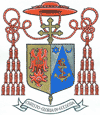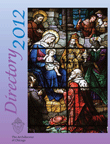
The Cardinal's Column
Francis Cardinal George, O.M.I.
What makes a saint?
Cardinal George's Schedule
- October 29: 10:30 a.m., Mass and Dedication of New Facility, Catholic Theological Union; 2:30 p.m., Annual Archdiocesan Awards Presentation, Holy Name Cathedral
- October 31: 5:30 p.m., Patrons of the Arts in the Vatican Museums Reception
- November 1: 9 a.m., Mass Marking Canonization of Mother Theodore Guerin, Guerin Prep High School
- November 2: 5:15 p.m., Mass for Feast of all Souls, Holy Name Cathedral
- November 3: 9 a.m., Divine Liturgy, Encounter of the Eastern Catholic Churches, Marriott O’Hare; 6:30 p.m., Italian American Labor Council of Greater Chicago Person of the Year Fall Gala, Crystal Palace Banquets, Park Ridge
- November 4: 1 p.m., Zacchaeus House Benefit Luncheon, Burr Ridge; 5:30 p.m., St. Nicholas Ukrainian Catholic Cathedral Parish Jubilee Banquet, Navy Pier
- November 5: 11:30 a.m., Mass at St. Thomas Becket Parish, Mt. Prospect
- November 6-7: Presbyteral Council Meeting, Mundelein
- November 9: Episcopal Council Meeting
- November 10: 5:30 p.m., Loyola University Chicago Stritch School of Medicine Annual Award Dinner, The Chicago Hilton
- November 11-16: United States Conference of Catholic Bishops Meeting, Baltimore, Maryland

As we approach the Feast of All Saints on Nov. 1, we recall that what makes a saint is God’s grace. But, on Oct. 15, I was in St. Peter’s Square in Rome when Pope Benedict XVI “made” four holy men and women saints in the calendar of the Church. They had cooperated with God’s grace and his will that we live intimately with him in this life and the next. The Church recognized that life of union with God in the canonization ceremony two weeks ago.
I was in Rome for the ceremony primarily because one of those canonized was Mother Theodore Guerin, the founder of the Sisters of Providence of St. Mary of the Woods in Indiana. All the bishops from the State of Indiana were present as well, and we all concelebrated the canonization Mass with the Pope. The Sisters of Providence have a long history in the Archdiocese of Chicago, primarily in education but in other ministries as well.
Mother Guerin joined the Sisters of Providence in her native France. She taught and cared for the sick for years, having been prepared for such ministry in caring for her own family after her father was murdered when she was fifteen and her mother was unable to carry alone all the burdens of raising her family. Perhaps because of the hardships of her life, she developed a keen sense of God’s abiding providence in human affairs. She trusted Divine Providence when she was sent to begin a new foundation of her religious Congregation in what was then a wilderness in southern Indiana. It was in many ways a hostile place, where the Sisters were often not only cold and hungry but also despised by Americans who had been taught that Catholic convents were hotbeds of immorality.
As her own health declined, her spiritual force, by the grace of God, was strengthened. She became Superior of the newly founded Sisters of Providence Congregation here and founded convents and schools in Indiana and Illinois. Mother Guerin lived from 1798 to l856. She knew her own weakness but relied always on God: “What strength the soul draws from prayer! In the midst of a storm, how sweet is the calm it finds in the heart of Jesus.”
Reliance on God in the midst of weakness and great difficulties characterized the lives of the three other saints canonized with Mother Guerin. Bishop Rafael Guizar Valencia (1878-1938) lived through the persecutions of the Church in his native Mexico. Born in the State of Michoacan, where so many of the Mexican Americans in Chicago have their family roots, he was ordained a priest in 1901. During the years of persecution, he disguised himself as a street peddler, a musician and a doctor of homeopathic medicine. These disguises enabled him to continue to minister, especially to the sick, and to administer the sacraments to the dying. Pursued by the anti-clerical Mexican government, he escaped first to the United States and then to Cuba. In 1919, he was named Bishop of Veracruz, but he spent the first nine years of his episcopate in exile or fleeing for his life during his brief visits to his diocese. At one point, he offered to give himself up to his persecutors if they would promise to give his people freedom of religion. His people trusted him and recognized the strength of God’s grace in his life. When we look with admiration at the deep faith of many Hispanic Catholics in the Archdiocese, we should look further and see behind them the example and ministry of Bishop Rafael Guizar.
Fr. Filippo Smaldone (1848-1923) was an Italian diocesan priest whose life was marked by an immense charity, with a special concern for those who are deaf and mute. Our ministry in Chicago to those who cannot hear or speak is strong because of the pastoral charity and dedication of Fr. Joseph Mulcrone. During the canonization Mass, I thought with gratitude of him and those who minister with him.
The fourth person declared a saint was Rosa Venerini (1656-1728), a young Italian woman who eventually gave her life to the cultural, moral and spiritual education of girls, opening the first public school for girls in Italy and founding an apostolic religious Congregation of “Pious School Teachers,” at a time when women religious were almost all members of cloistered orders. “Educate to save” was her motto, and it could serve as the motto for our Catholic schools here in the Archdiocese.
Salvation is found in surrender to God’s will for us. Trusting in his Providence rather than our own desires, plans and designs, we travel the way to sanctity on a path not of our own choosing; and that’s the point. If we want to be saints, we have to pray daily for the gift of holiness and then live each day in cooperation with God’s grace. At the heart of a saintly life is self-surrender. At the beginning of his homily during the Mass of canonization, Pope Benedict XVI reflected on the Gospel account of the rich young man, who refused to follow Christ because he was unable to bring himself to sell all that he had and give his money to the poor. The Pope explained that, “a saint is that man or that woman who, responding with joy and generosity to the call of Christ, leaves everything to follow him.” That is extremely hard because each of us wants to hold something back as his or her own, making it impossible for God to give it back to us as a gift from him rather than a possession we have hoarded for ourselves.
During the week after the canonization, the President of the U.S. Bishops’ Conference, Bishop William Skylstad, and I visited the heads of many departments in the Vatican and even spoke with the Pope. The diversity and universality of the Church is always evident in these conversations. But the heart of the Church became visible during the canonization ceremony; and each of us is called to be part of that heart, no matter our station in life.
During the month of November, as we pray for those who have gone before us in faith, let us pray also for one another in the community of faith, that God may make us saints.
Sincerely yours in Christ,
Francis Cardinal George, OMI
Archbishop of Chicago



